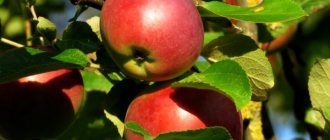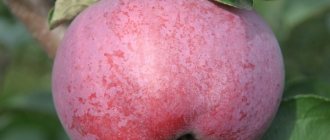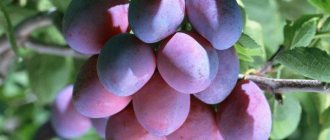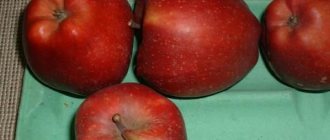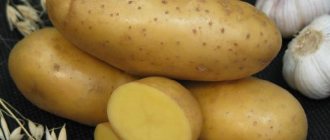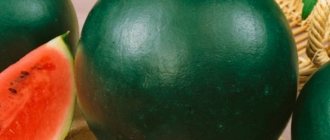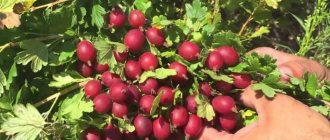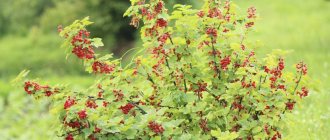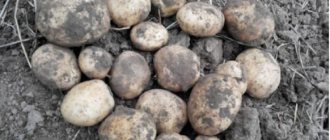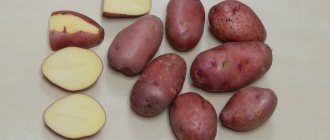Characteristics of the variety
The technical characteristics of the Cherry variety need to be considered in more detail in order to determine the subtleties of planting and care.
Tree dimensions
The apple tree is medium in size, its usual height is 4 meters. The crown is formed from thin, neat branches, folded into a round and compact hat. The photo shows how the skeletal shoots are located.
Cherry apple variety tree.
Branches
The branches extend from the trunk at right angles. Young shoots can be an interesting reddish color. The fruit twigs on which the ovaries appear are small but elastic.
Escapes
Most often, the shoots are straight and medium in thickness. They are arranged compactly and neatly. Internodes are quite short, lentils are frequent.
Leaves
The leaves are medium sized, smooth and slightly pubescent. Their shape is ovoid, with small serrations on the edges.
Fruit
Fruits of the Cherry variety are usually regular or slightly round in shape. Size varies from 110 to 130 grams. The skin is yellow-green, with a beautiful blush, covered with a light waxy coating.
Cherry apple tree fruits.
Tasting assessment
The taste of the pulp is described as harmonious, sweet and sour. It is soft and tender, fragrant. For taste, Cherry received a mark of 4.3 points, and for appearance - 4.5.
Fruit harvest time
Harvesting of ripe fruits usually occurs in September. Depending on climatic conditions, it may shift, but usually occurs at the beginning of the month. But apples acquire taste after 10-14 days.
Harvest shelf life
Fruits can be stored for 150-180 days from the moment of picking. However, this is only possible if appropriate conditions are provided: temperature and humidity. Fruits can be transported over long distances.
Productivity
Yields are described as average. About 130-150 kg of fruit can be collected from the tree annually. There are no breaks in fruiting.
Apple harvest.
History and description of the Cherry variety
The apple tree got its name because of the bright, rich color of the apples. The hybrid was bred by Russian scientists at the All-Russian Research Institute of Horticulture named after. Michurina. The ancestors were the varieties Antonovka ordinary and Pepin saffron.
Did you know? In English, the name apple is associated with Apollo. Fruits were brought as a gift to this ancient Greek god, and the apple tree itself was considered a sacred tree.
Most often, the Cherry apple tree is grown in the Tambov and Voronezh regions, but this variety can also be cultivated in other regions of Russia. Despite early ripening, the variety is defined as winter. The fruiting period begins in the fifth year of life. With proper care, you can achieve a yield of 300 centners or more per 1 hectare.
The apple tree blooms with white or cream inflorescences, profusely, in mid-May, and by the middle of the first autumn month the apples are ready for picking. The presentation and taste characteristics of the fruit are preserved until February. The hybrid does not differ in winter hardiness - even in moderate cold there is a risk of damage to the bark.
At the same time, the flowers are resistant to spring frosts. In summer, the tree requires stable watering, since the variety is not drought-resistant. We also cannot praise the tree’s immunity to scab - during the rainy, cold season, the apple tree suffers from fungal diseases. The transportability of fruits is quite high. They are consumed fresh, and jams, juices, and preserves are also prepared from them.
Important! The Cherry hybrid is self-sterile and requires pollinators. The “parents” of the apple tree - Pepin saffron and Antonovka vulgare, as well as Northern Sinap - cope well with this role.
The tree of the Cherry variety is medium-sized, with a lush, dense branched part. The crown shape is spherical or flat-round. The bark of the trunk has a reddish tint, and the branches are painted in cherry shades. The leaves are medium-sized, ovoid, with small gaps. The leaf blade is dense and smooth.
The fruits have the shape of a ball or a rounded cone. The average weight of an apple is 110–120 g. The fruits have thin skin with a light waxy coating. Numerous specks are barely visible under the skin. When technically ripe, apples become yellow-green and have a characteristic pink blush.
When fully ripe they become cherry. The stalks are short and plump, with a small olive funnel. Apple seeds are dark burgundy in color. Ripe pulp is white, fine-grained. It tastes sweet and sour, juicy, with a characteristic aroma.
Precociousness
The early fruitfulness of the variety is at an average level. The harvest can be harvested 5-6 years after planting, but you can try the first few fruits in the third year.
Winter hardiness
In harsh winters, the apple tree may freeze. In normal winter cold, the suffering of the apple tree is minimal. There are also damages to the apple tree during spring frosts, but they are completely minimal.
Disease resistance
The Cherry apple tree variety has an average level of immunity to scab and other fungal diseases. Only in conditions of excess moisture or a severe epidemic is defeat possible.
Pollinator varieties
The varieties on which the hybrid was created are best suited for pollination - Antonovka or Pepin. But if there are no such ones nearby, then those that bloom at the same time will do. The varietal characteristics do not change due to pollination with other varieties.
Pest and disease control methods
Since the Cherry variety is not resistant to scab, it needs to be protected from this disease.
Did you know? The smallest apple was slightly larger than a pea, and the largest
-
the size of a newborn baby's head.
To do this, regularly treat the wood:
- In the spring, before the buds open, the soil near the tree and the crown are treated with copper sulfate or a solution of Bordeaux mixture.
- Before flowering begins, spray with potassium humate or Fitosporin-M.
- After the leaves fall in mid-autumn, leaves and other debris near the apple tree are removed, and the tree is again treated with Bordeaux mixture and copper sulfate.
Pests attack a crop when its immunity is weakened. However, they can infect the entire tree. Mites, aphids and psyllids feed on plant sap (buds, leaves, buds), apple moths spoil the foliage, and sawflies and codling moths harm the fruits.
Important! Any chemical treatments must be completed 3 weeks before harvest.
They fight them in the following ways:
- Aphid. To get rid of it, the tree is treated with a solution of Karbofos, Nitrafen or tobacco decoction mixed with soap.
- Apple mite. It is destroyed by “Dicofol” and “Karbofos”, which alternate.
- Psyllad. To prevent its appearance when buds open, treat the tree with Karbofos or Nitrafen. Some gardeners advise fumigating the apple tree with tobacco smoke for 2–3 hours.
- Apple moth. Prevention is carried out when the first leaves appear and after flowering. The tree is sprayed with Zolon or chlorophos solution.
Landing
Planting of the Vishnevka apple tree variety follows the standard scheme, without any additional costs. It is better to choose a seedling in advance and buy it at a nursery. The technology is familiar to all gardeners.
Preparing the hole and properly planting the apple tree.
The place should be well lit and protected from strong winds. It is important to avoid planting in areas where there may be waterlogging or where groundwater is close.
Deadlines
Planting can be carried out in spring or autumn. In summer, only seedlings with a closed root system are planted. But they need to be given attention and provided with watering and protection from the sun.
Technology
The landing takes place according to a certain algorithm:
- Preparing the planting hole. It needs to be dug up in advance, fertilized and, if necessary, improved structure.
- Place the seedling in the middle and place a peg nearby for support.
- Spread the roots to the sides, sprinkle with soil, leaving the neck of the root on top.
- Water and shorten the branches by a third.
In a few days, when the soil has settled, you still need to add more soil, water it and mulch it.
Growing
The Cherry variety apple tree grows quite independently and does not require special attention. There are no subtleties as such, but there are several nuances.
Apple tree seedlings for planting.
Caring for a young seedling
Pests often attack young plantings of the Cherry variety. Therefore, in the spring it is necessary to carry out preventive spraying; in some cases, fishing belts are used. For the winter, you need to insulate the trunk and at the same time protect the tree from rodents.
A young tree needs regular watering. Nitrogen fertilizers must be applied every spring to stimulate seedling growth.
Pruning and crown formation
The formation of the crown of Cherry begins to be carried out very early, even in the first year after planting. Damaged and spiny shoots are cut off, as well as those that grow in the middle of the crown. A young apple tree is pruned once per season, but an adult one must be pruned twice. It is important to cut branches with a clean tool to prevent disease.
Columnar option
The columnar Cherry apple tree does not exist. Let's talk in general about columnar apple trees.
This variety of apple tree is popular due to its compact size and rapid entry into fruiting. Such seedlings can be planted at a distance of half a meter from each other.
Columnar apple trees bloom in the second year after planting, which makes them attractive for both private and industrial gardening.
The columnar-shaped apple tree grows no more than 2.5 meters in height and can form short side shoots. This happens because the top of the seedling freezes, and in the spring the trunk grows into 2 branches. In this case, one of them, the weaker one, is removed.
Without pruning, a columnar tree can turn into a weakly pyramidal tree 70-90 cm wide.
Important! It makes sense to grow a columnar apple tree in warm climates or cover it every winter.
Just like a regular apple tree, this species needs pollinators.
Features of ripening and fruiting
In order for fruiting to be abundant, pollinators need to bloom in May, when the fragrant flowers of the Cherry apple tree variety open. Beautiful abundant beige or white blooms attract many insects.
Apples of the Cherry variety.
Abundant fruiting of the Cherry variety begins only in the fifth year of the tree’s life. And since then there has been no stop in fruiting. A healthy tree is harvested every year.
The Cherry harvest is harvested in September, usually at the beginning of the month, but under conditions of insufficient temperature it can even be at the end. Although apples can be consumed immediately after picking, it is advisable to set them aside for a week or two to allow the sourness to go away. But very often sweet preparations are prepared from the Cherry fruits.
Storage is possible until February. In order for the fruits not to lose their marketability and taste, they should be placed in a place where the temperature is about 0 degrees and high humidity.
Harvesting and storage
The harvest begins in the first half of September. You can store it until the last winter month and at the same time all its taste and beneficial properties will be preserved. From one mature apple tree you can harvest about 140 kilograms annually. The apple tree has an average early fruiting period, so the first harvests can be harvested 6 years after planting in the garden. It has average resistance to frost, which is why the shoots of the first year of life can freeze, during During spring frosts, fruit buds are damaged.
The apple tree is resistant to disease and can develop fungal diseases or scab in years with particularly high humidity. Mother varieties and Northern Sinap are suitable for pollinating the plant.
When planting and cultivating an apple tree in the recommended climatic conditions, September is considered the standard time for harvesting ripe fruits. The fruits have fairly high commercial and consumer qualities. The period of consumer use of apples begins two weeks after picking and lasts until mid-February.
Peculiarities of cultivation in the Moscow region and the Central zone
The Chernovoye apple variety is zoned for the stable climate of the Central Black Earth region. But Moscow and the region do not have cozy and comfortable winters.
Growing in this region is possible subject to several conditions:
- young seedlings cover the first few years of life;
- the trunk must be whitened in spring and autumn so that frost damage and burns do not appear on it;
- It is better to fertilize and mulch the tree trunk circle in the fall;
- If young branches are frozen due to spring frosts, then it is better to cut them off.
Growing Cherry apple trees in a garden near Moscow.
A tree can grow in the Moscow region, but only if it is provided with additional shelter. In other colder regions, the apple tree will not take root. Even in the middle zone, during cold winters, the apple tree sometimes freezes.
Care requirements
The cherry apple tree variety needs timely and competent care, especially in the first years of life:
- Watering. To ensure good survival rate and rapid growth, young trees need to be watered regularly - as the earthen clod dries out and at least five times throughout the entire season. The first moistening is carried out at the beginning of spring, then two weeks before flowering and two weeks after it. Seedlings are also watered during the formation of fruit ovaries and in late autumn to increase frost resistance.
- After each watering, the soil is loosened, removing weeds and plant debris. These manipulations help protect the tree from drying out and the appearance of diseases and parasites.
- To retain moisture in the soil, after each watering, the tree trunk area is mulched with garden soil, forming a small mound - 5-7 cm high.
- Feeding. After planting, the seedlings do not need to be fed - the nutrients will last for another 2 years. Starting from the 3rd year of life, apple trees are fertilized with complex preparations that include organic and mineral components. In early spring, nitrogen-containing preparations are applied to the tree trunk zone, before and after flowering - superphosphate and potassium salt. A week before the expected autumn cold, the trees are fed with complex fertilizers with a low nitrogen content.
- Pruning and shaping the crown for this plant are mandatory, given that the cherry tree quickly grows young growth and the crown becomes thickened. Its thinning is carried out in early spring - before the start of the sap flow process or in late autumn - after leaf fall. Pruning is combined with sanitary cutting - all branches damaged by frost, winds and diseases are cut out. To avoid infection, all cuts are covered with garden varnish.
- Preparing for winter. Young seedlings do not have the same immunity as mature trees, so before the onset of the first autumn frosts, they are covered. First, the tree trunk area is mulched, then covered with spruce branches, sawdust or fallen leaves, and after snow falls, covered with a snowdrift. In such conditions, the risk of wood freezing is reduced to zero.
- Prevention of diseases and pests. In the absence of good nutrition and regular watering in a garden where there are continuous thickets of weeds, the apple tree can develop powdery mildew, cytosporosis and other types of viral and fungal infections. Therefore, it is important to optimize care and carry out preventive treatments of the crown and soil with copper-containing preparations - copper sulfate or Bordeaux mixture. For parasites, both folk remedies are used (garlic, tobacco infusion, ash-soap solution) and pesticides - Aktellik, Aktaru, Fundazol.
Useful tips
Not everyone likes to listen to advice, much less apply it. However, here they are:
- To prevent the apple tree from freezing, it needs to be insulated: both the tree trunk and the trunk.
- If you whiten the trunk in the fall, there is a greater chance that the shoots will not get burned by the bright sun in winter.
- If the shoots are frozen, you need to cut them off and feed the crop itself.
- If for no apparent reason the variety begins to wither and dry out, look for pests.
- To preserve fruits longer, remove them carefully and pack them in paper.
Such useful tips will help preserve your apple tree and harvest.
Advantages and disadvantages
When choosing an apple tree for a plot, it is necessary to study the advantages and disadvantages of the variety. Advantages of the Cherry apple tree:
- resistance to scab;
- stable and regular harvests;
- long storage period for ripe apples;
- presentation of the fruit;
- precociousness;
- high yield.
The disadvantages of the variety include:
- average frost resistance;
- lack of aroma from apples;
- poor drought resistance;
- late apple picking period.
To achieve a bountiful harvest, it is necessary to have pollinating apple trees, which are used as Pepin Saffron, Northern Sinap.
Reviews
Sergei Lyudvigovich: “We planted the Cherry apple tree in the spring, it seemed to have taken root over the summer, but just this winter there was a severe frost. The tree disappeared, it’s a shame, of course, but it’s my own fault. It was necessary to take into account that it is heat-loving.”
Ulyana Sergeevna: “The Cherry apple tree was planted in the fall, the very next year the first flowers appeared, but we tore them off. They left a few only for the third year. I can’t say that they are sweet; those who like sourness will like them more. But juicy and flavorful.”
Viktor Fedorovich: “My apple tree doesn’t freeze, but every year it gets scab. And in the spring I constantly spray it for prevention, and I keep an eye on my neighbors. But this is the only drawback - otherwise there are no problems.”
